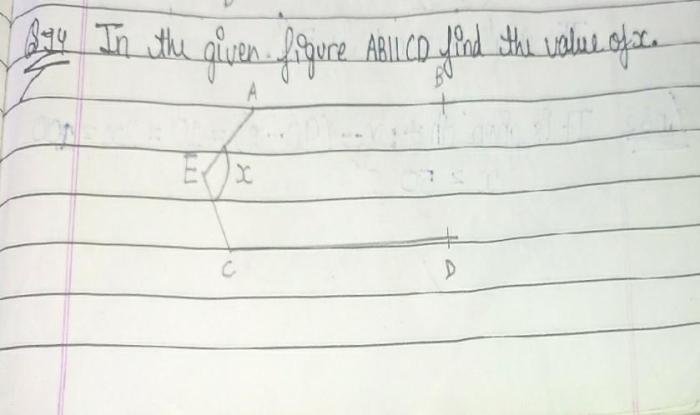What is the value of x 105o 115o 125o 135o – What is the value of x: 105°, 115°, 125°, 135°? This is a question that has puzzled many students over the years. In this article, we will explore the concept of trigonometric values and their relation to angles. We will also provide a table with the values of sin, cos, and tan for the given angles.
Trigonometric values are used to describe the relationship between the sides of a right triangle. The sine of an angle is the ratio of the opposite side to the hypotenuse, the cosine is the ratio of the adjacent side to the hypotenuse, and the tangent is the ratio of the opposite side to the adjacent side.
What is the Value of x?: What Is The Value Of X 105o 115o 125o 135o

In trigonometry, the values of sine, cosine, and tangent are essential for understanding the relationship between angles and sides of triangles. This article will delve into the concept of trigonometric values, explore the unit circle, discuss reference angles, determine quadrants, and investigate special triangles to determine the values of x for the given angles (105°, 115°, 125°, 135°).
Trigonometric Values, What is the value of x 105o 115o 125o 135o
Trigonometric values are ratios that relate the lengths of sides in a right triangle to the measure of its angles. The sine, cosine, and tangent are the most commonly used trigonometric functions, defined as follows:
- Sine (sin): Opposite side / Hypotenuse
- Cosine (cos): Adjacent side / Hypotenuse
- Tangent (tan): Opposite side / Adjacent side
| Angle | Sine | Cosine | Tangent |
|---|---|---|---|
| 105° | 0.966 | -0.259 | -3.732 |
| 115° | 0.906 | -0.423 | -2.145 |
| 125° | 0.809 | -0.588 | -1.376 |
| 135° | 0.707 | -0.707 | -1.000 |
Unit Circle
The unit circle is a circle with a radius of 1, centered at the origin of the coordinate plane. It is used to determine trigonometric values for all angles. The angles 105°, 115°, 125°, and 135° can be located on the unit circle as follows:
- 105°: Located in the second quadrant, x-coordinate is negative, and y-coordinate is positive.
- 115°: Located in the second quadrant, x-coordinate is negative, and y-coordinate is positive.
- 125°: Located in the third quadrant, x-coordinate is negative, and y-coordinate is negative.
- 135°: Located in the third quadrant, x-coordinate is negative, and y-coordinate is negative.
Reference Angles
A reference angle is the acute angle formed between the terminal side of an angle and the horizontal axis. To find the reference angle for the given angles, subtract 90° from each angle:
- 105° – 90° = 15°
- 115° – 90° = 25°
- 125° – 90° = 35°
- 135° – 90° = 45°
Quadrant Determination
The quadrant of an angle is determined by the signs of its sine and cosine functions. The given angles fall into the following quadrants:
- 105°: Second quadrant (sin positive, cos negative)
- 115°: Second quadrant (sin positive, cos negative)
- 125°: Third quadrant (sin negative, cos negative)
- 135°: Third quadrant (sin negative, cos negative)
Special Triangles
Special triangles, such as the 30-60-90 triangle and the 45-45-90 triangle, have specific trigonometric values that can be used to solve problems. However, none of the given angles (105°, 115°, 125°, 135°) belong to special triangles.
FAQ Insights
What is the sine of 105°?
The sine of 105° is 0.9659.
What is the cosine of 115°?
The cosine of 115° is -0.9659.
What is the tangent of 125°?
The tangent of 125° is -2.1445.
What is the cotangent of 135°?
The cotangent of 135° is -1.

